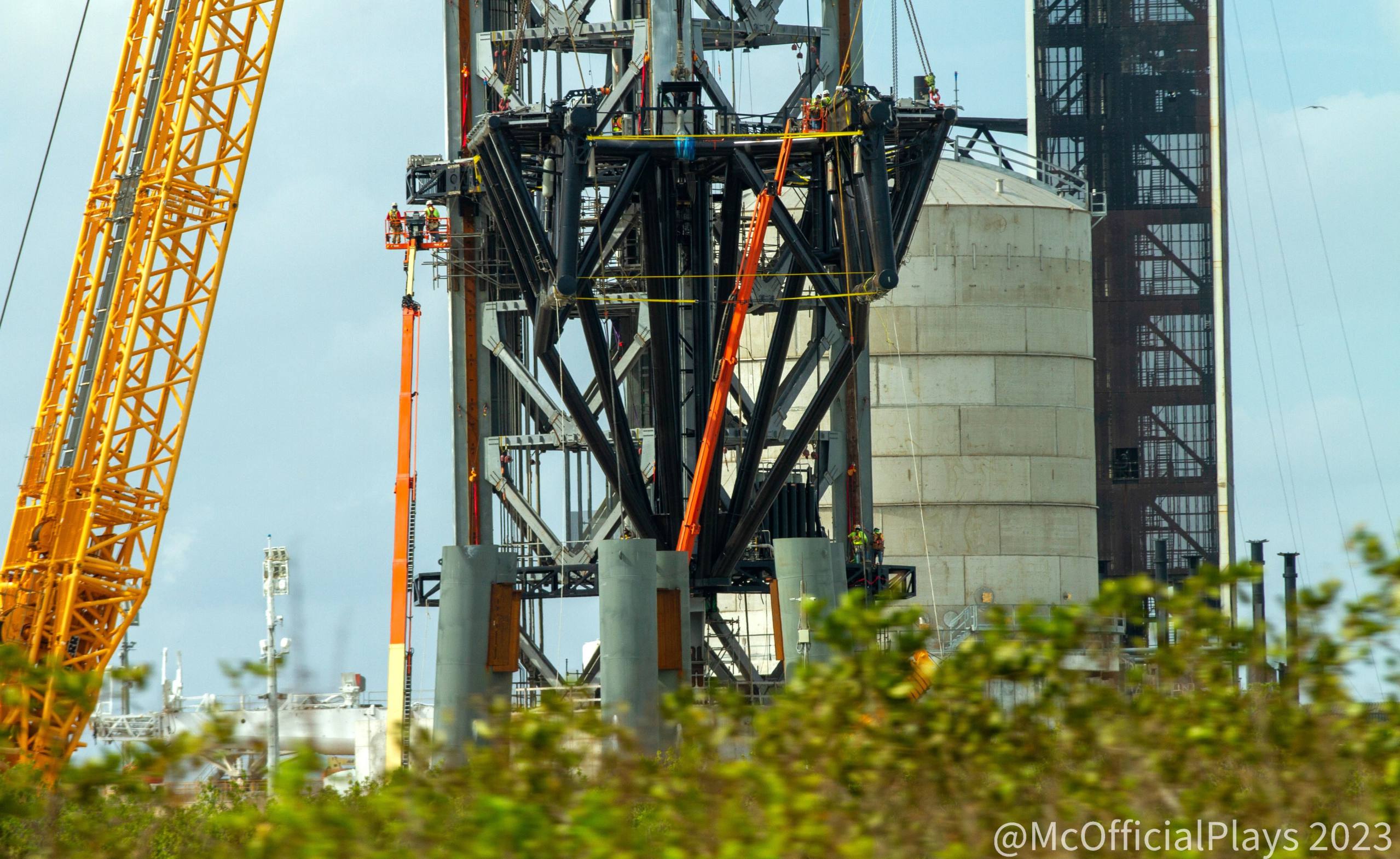
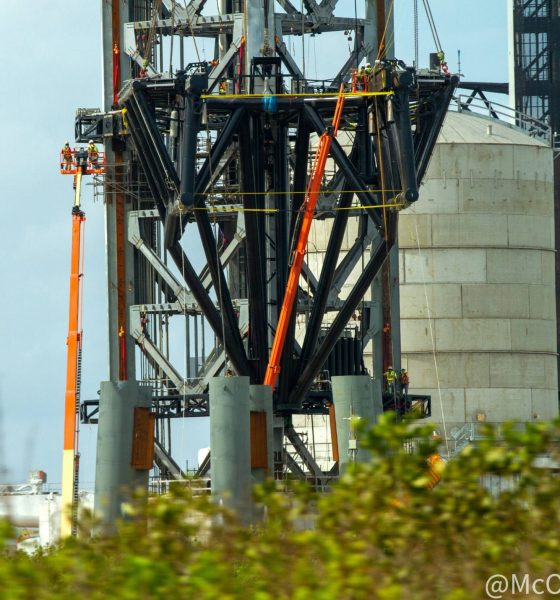
News
SpaceX installs rocket-catching arms on Starship’s Florida launch tower
SpaceX has installed a pair of rocket-catching arms on a tower meant to support the first East Coast launches of its next-generation Starship rocket.
The company has been building the second of several planned Starship launch sites for more than three years. Ironically, work on that pad began before the company started building the pad that will actually support Starship’s first orbital launch attempts. Located a stone’s throw from the Gulf of Mexico in Boca Chica, Texas, the first iteration of SpaceX’s Starbase orbital launch site (OLS) is nearly complete and could host Starship’s orbital launch debut in a matter of months. SpaceX began constructing Starship’s Texas launch site in earnest in late 2020.
SpaceX broke ground on Starship’s first Florida OLS in late 2019. But the company went on to radically redesign the rocket and its ground systems, forcing it to entirely abandon about a year of work by the end of 2020. In late 2021, SpaceX finally began constructing the second iteration of Starship’s first Florida pad. OLS #2 is still colocated at Kennedy Space Center’s LC-39A pad, which SpaceX leases from NASA. Pad 39A is the only site currently capable of launching SpaceX’s Crew Dragon astronaut spacecraft or Falcon Heavy rocket, which has complicated its plans to use the same pad for Starship.
The update that's rolling out to the fleet makes full use of the front and rear steering travel to minimize turning circle. In this case a reduction of 1.6 feet just over the air— Wes (@wmorrill3) April 16, 2024
Because of NASA’s trepidation at the thought of a Starship failure indefinitely delaying SpaceX from completing its Crew Dragon or Falcon Heavy contracts for the agency, the company deprioritized Starship’s Florida pad, slowing progress. SpaceX has, nonetheless, made significant progress. In 13 months, SpaceX has created foundations, modified one of Pad 39A’s giant spherical tanks to store cryogenic methane, installed miles of plumbing, built and assembled a second skyscraper-sized Starship launch tower, installed the legs of the pad’s ‘orbital launch mount’ or OLM, installed a water deluge system at the base of the OLM, assembled most of the OLM’s donut-like mount offsite, constructed a new supersized storage tank, and delivered a forest of smaller storage tanks.
Most recently, SpaceX finished building a giant pair of steel arms, transported the arms to Pad 39A, attached them to a wheeled carriage, and installed the structure on Starship’s Florida launch tower. SpaceX employees have nicknamed the arms “chopsticks,” and those arms are integral to what CEO Elon Musk calls “Mechazilla”. Mechazilla refers to the combined launch tower and arms, which SpaceX has designed to grab, lift, stack, and fuel both stages of Starship.
Mechazilla’s simplest part is a third arm that is vertically fixed in place but capable of swinging left and right. The swing arm contains plumbing and an umbilical device that connects to Starship’s upper stage and supplies propellant, gas, power, and connectivity. The tower’s ‘chopsticks’ are far more complex. Giant hinges connect the pair of arms to a carriage that grabs onto three of the tower’s four legs with a dozen skate-like appendages. Those skates are outfitted with wheels, allowing the carriage to roll up and down tracks built into the tower’s legs.
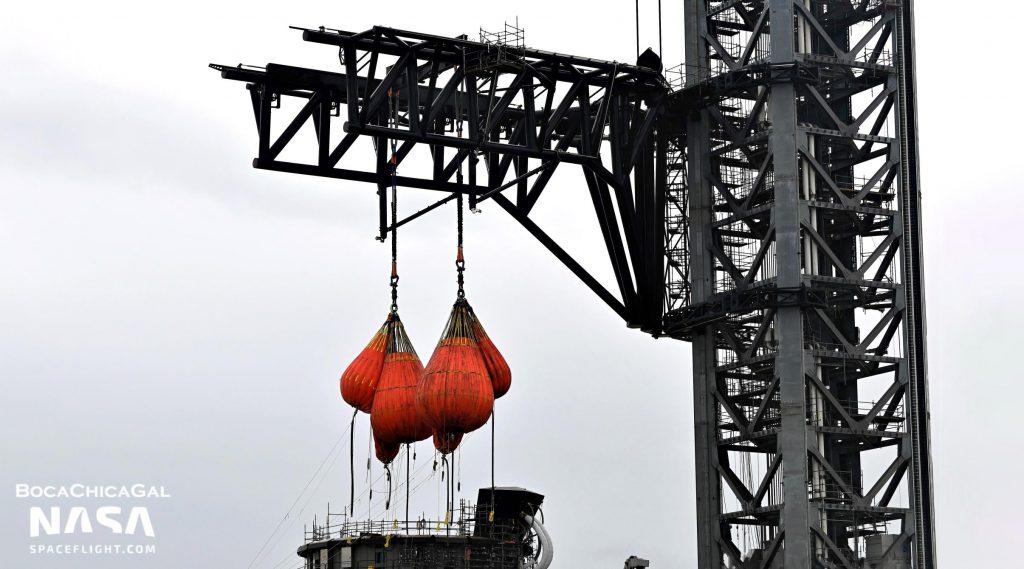

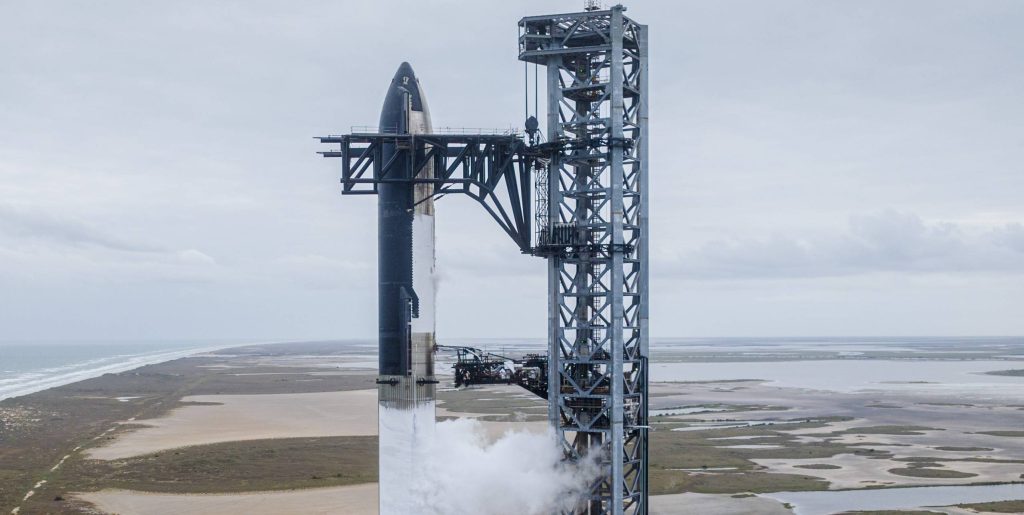
The carriage, which also carries the complex hydraulic systems that allow its bus-sized arms to move, is connected by steel cable to a heavy-duty “draw works” capable of hoisting the multi-hundred-ton assembly up and down the tower. Once finished, the Florida tower’s arms will be able to precisely lift, maneuver, stack, and de-stack Starship and Super Heavy even in relatively windy conditions. At some point in the future, SpaceX may attempt to use its towers and chopsticks to catch Starships and Super Heavies out of mid-air and speed up reuse.
Set to be the largest, most powerful, and most capable rocket in history, Starship is primarily built out of steel and designed to be fully reusable. SpaceX has a long way to go to demonstrate that the 120-meter-tall (~390 ft) rocket can reach orbit, let alone be reused. In theory, though, Starship is meant to launch up to 150 metric tons (330,000 lb) to low Earth orbit (LEO) while still allowing for the recovery and reuse of its suborbital Super Heavy booster and orbital Starship upper stage.
If SpaceX can achieve those figures, Starship will be the most capable rocket in history even with the major performance penalties that full reusability entails. Saturn V, the most capable rocket ever flown, was fully expendable and could launch up to 118 metric tons (~260,000 lb) into orbit.
Due to NASA’s concerns about the risks that Starship launches from Pad 39A could pose to SpaceX’s Falcon and Dragon operations at the same site, the company’s next-generation rocket may have to wait until 2024 or 2025 for its first Florida launch. With the first Florida Mechazilla now close to completion, it’s likely that Pad 39A’s Starship launch site will be ready and waiting as soon as NASA gives SpaceX the green light.

News
Tesla hosts Rome Mayor for first Italian FSD Supervised road demo
The event marked the first time an Italian mayor tested the advanced driver-assistance system in person in Rome’s urban streets.
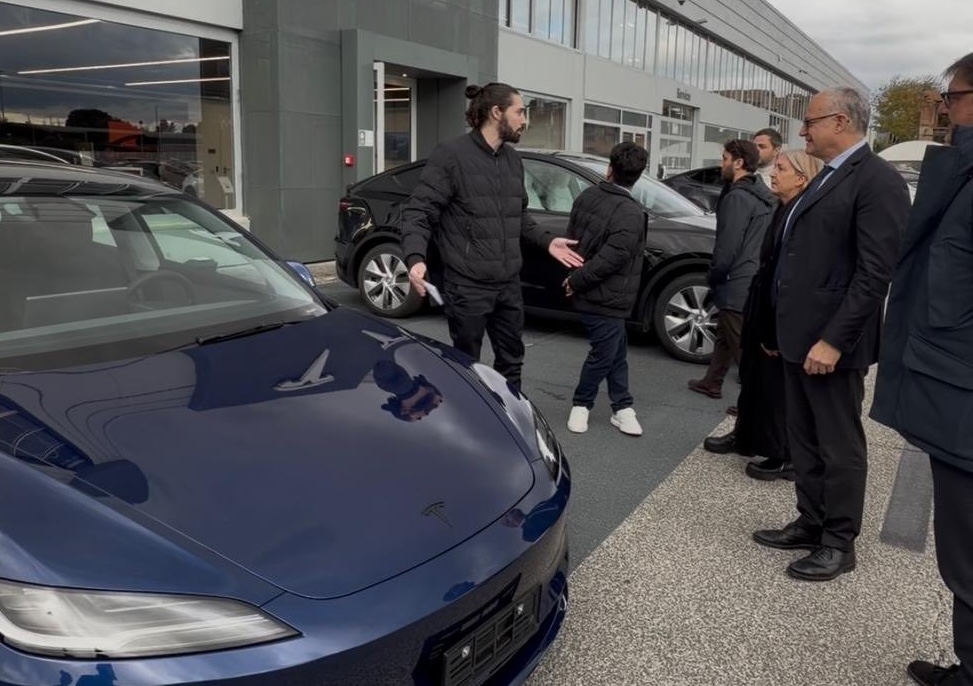
Tesla definitely seems to be actively engaging European officials on FSD’s capabilities, with the company hosting Rome Mayor Roberto Gualtieri and Mobility Assessor Eugenio Patanè for a hands-on road demonstration.
The event marked the first time an Italian mayor tested the advanced driver-assistance system in person in Rome’s urban streets. This comes amid Tesla’s push for FSD’s EU regulatory approvals in the coming year.
Rome officials experience FSD Supervised
Tesla conducted the demo using a Model 3 equipped with Full Self-Driving (Supervised), tackling typical Roman traffic including complex intersections, roundabouts, pedestrian crossings and mixed users like cars, bikes and scooters.
The system showcased AI-based assisted driving, prioritizing safety while maintaining flow. FSD also handled overtakes and lane decisions, though with constant driver supervision.
Investor Andrea Stroppa detailed the event on X, noting the system’s potential to reduce severe collision risks by up to seven times compared to traditional driving, based on Tesla’s data from billions of global fleet miles. The session highlighted FSD’s role as an assistance tool in its Supervised form, not a replacement, with the driver fully responsible at all times.
Path to European rollout
Tesla has logged over 1 million kilometers of testing across 17 European countries, including Italy, to refine FSD for local conditions. The fact that Rome officials personally tested FSD Supervised bodes well for the program’s approval, as it suggests that key individuals are closely watching Tesla’s efforts and innovations.
Assessor Patanè also highlighted the administration’s interest in technologies that boost road safety and urban travel quality, viewing them as aids for both private and public transport while respecting rules.
Replies on X urged involving Italy’s Transport Ministry to speed approvals, with one user noting, “Great idea to involve the mayor! It would be necessary to involve components of the Ministry of Transport and the government as soon as possible: it’s they who can accelerate the approval of FSD in Italy.”
News
Tesla FSD (Supervised) blows away French journalist after test ride
Cadot described FSD as “mind-blowing,” both for the safety of the vehicle’s driving and the “humanity” of its driving behaviors.
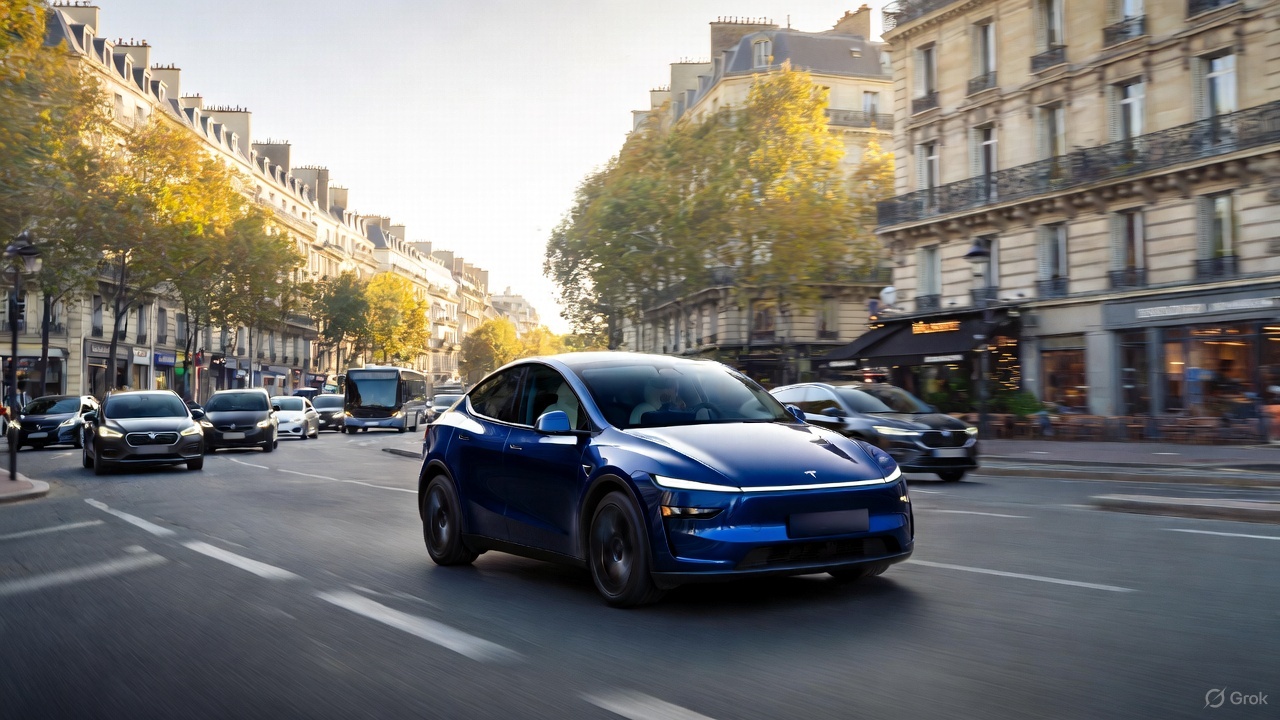
Tesla’s Full Self-Driving (Supervised) seems to be making waves in Europe, with French tech journalist Julien Cadot recently sharing a positive first-hand experience from a supervised test drive in France.
Cadot, who tested the system for Numerama after eight years of anticipation since early Autopilot trials, described FSD as “mind-blowing,” both for the safety of the vehicle’s driving and the “humanity” of its driving behaviors.
Julien Cadot’s FSD test in France
Cadot announced his upcoming test on X, writing in French: “I’m going to test Tesla’s FSD for Numerama in France. 8 years I’ve been waiting to relive the sensations of our very first contact with the unbridled Autopilot of the 2016s.” He followed up shortly after with an initial reaction, writing: “I don’t want to spoil too much because as media we were allowed to film everything and I have a huge video coming… But: it’s mind-blowing! Both for safety and for the ‘humanity’ of the choices.”
His later posts detailed FSD’s specific maneuvers that he found particularly compelling. These include the vehicle safely overtaking a delivery truck by inches, something Cadot said he personally would avoid to protect his rims, but FSD handled flawlessly. He also praised FSD’s cyclist overtakes, as the system always maintained the required 1.5-meter distance by encroaching on the opposite lane when clear. Ultimately, Cadot noted FSD’s decision-making prioritized safety and advancement, which is pretty remarkable.
FSD’s ‘human’ edge over Autopilot
When asked if FSD felt light-years ahead of standard Autopilot, Cadot replied: “It’s incomparable, it’s not the same language.” He elaborated on scenarios like bypassing a parked delivery truck across a solid white line, where FSD assessed safety and proceeded just as a human driver might, rather than halting indefinitely. This “humanity” impressed Cadot the most, as it allowed FSD to fluidly navigate real-world chaos like urban Paris traffic.
Tesla is currently hard at work pushing for the rollout of FSD to several European countries. Recent reports have revealed that Tesla has received approval to operate 19 FSD test vehicles on Spain’s roads, though this number could increase as the program develops. As per the Dirección General de Tráfico (DGT), Tesla would be able to operate its FSD fleet on any national route across Spain. Recent job openings also hint at Tesla starting FSD tests in Austria. Apart from this, the company is also holding FSD demonstrations in Germany, France, and Italy.
Elon Musk
Tesla Optimus shows off its newest capability as progress accelerates

Tesla Optimus showed off its newest capability as progress on the project continues to accelerate toward an ultimate goal of mass production in the coming years.
Tesla is still developing Optimus and preparing for the first stages of mass production, where units would be sold and shipped to customers. CEO Elon Musk has always marketed the humanoid robot as the biggest product in history, even outside of Tesla, but of all time.
He believes it will eliminate the need to manually perform monotonous tasks, like cleaning, mowing the lawn, and folding laundry.
However, lately, Musk has revealed even bigger plans for Optimus, including the ability to relieve humans of work entirely within the next 20 years.
JUST IN: Elon Musk says working will be ‘optional’ in less than 20 years because of AI and robotics. pic.twitter.com/l3S5kl5HBB
— Watcher.Guru (@WatcherGuru) November 30, 2025
Development at Tesla’s Artificial Intelligence and Robotics teams has progressed, and a new video was shown of the robot taking a light jog with what appeared to be some pretty natural form:
Just set a new PR in the lab pic.twitter.com/8kJ2om7uV7
— Tesla Optimus (@Tesla_Optimus) December 2, 2025
Optimus has also made several public appearances lately, including one at the Neural Information Processing Systems, or NeurIPS Conference. Some spectators shared videos of Optimus’s charging rig, as well as its movements and capabilities, most interestingly, the hand:
You have to hand it to Elon 🤟 pic.twitter.com/fZKDlmGAbe
— Ric Burton · NeurIPS 2025 (@_ricburton) December 2, 2025
The hand, forearm, and fingers have been one of the most evident challenges for Tesla in recent times, especially as it continues to work on its 3rd Generation iteration of Optimus.
Musk said during the Q3 Earnings Call:
“I don’t want to downplay the difficulty, but it’s an incredibly difficult thing, especially to create a hand that is as dexterous and capable as the human hand, which is incredible. The human hand is an incredible thing. The more you study the human hand, the more incredible you realize it is, and why you need four fingers and a thumb, why the fingers have certain degrees of freedom, why the various muscles are of different strengths, and fingers are of different lengths. It turns out that those are all there for a reason.”
The interesting part of the Optimus program so far is the fact that Tesla has made a lot of progress with other portions of the project, like movement, for example, which appears to have come a long way.
However, without a functional hand and fingers, Optimus could be rendered relatively useless, so it is evident that it has to figure this crucial part out first.








